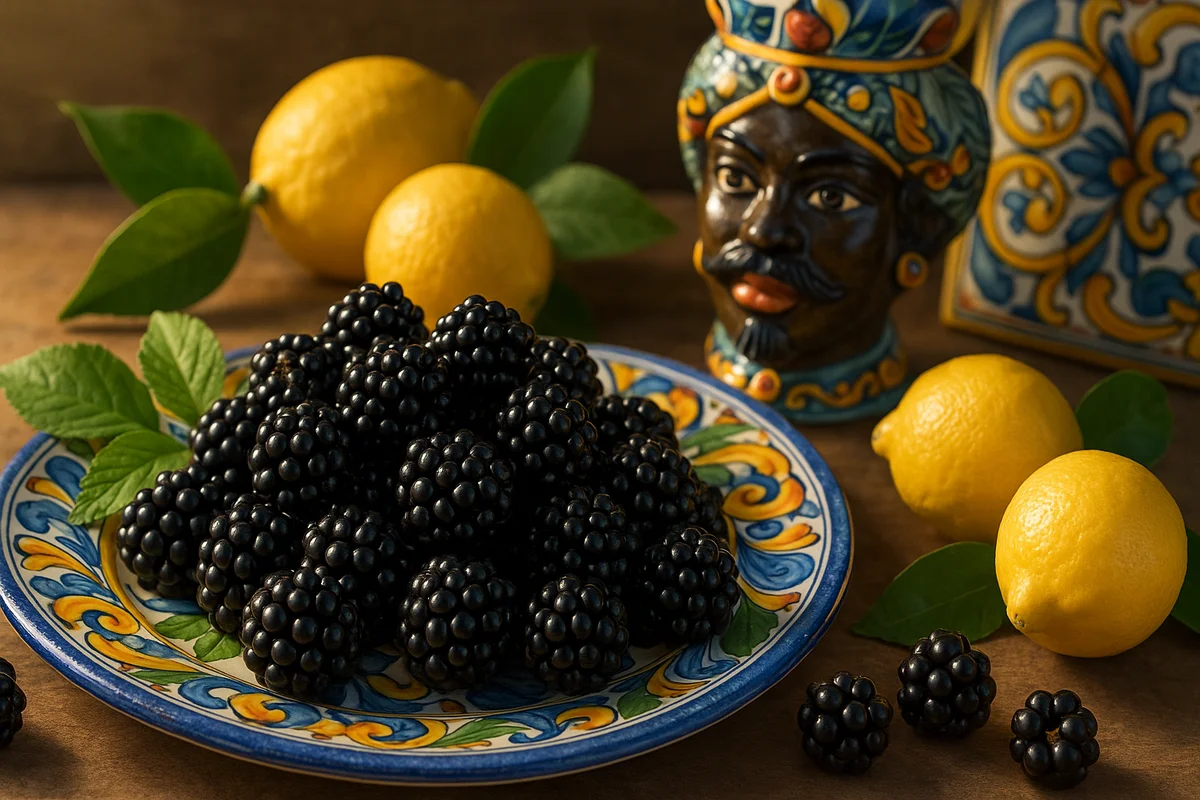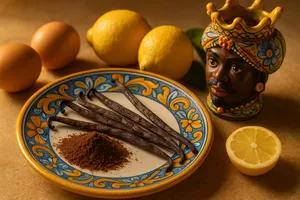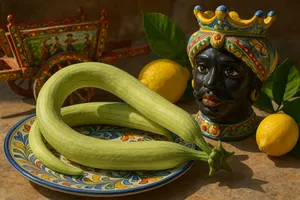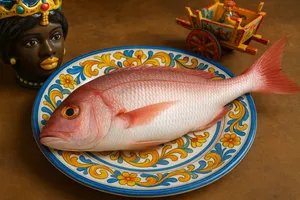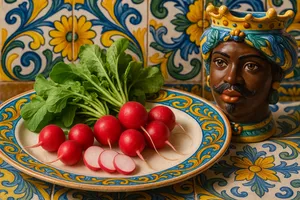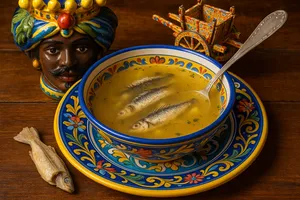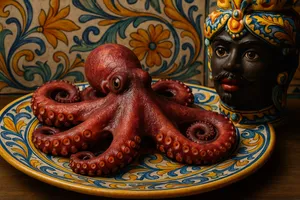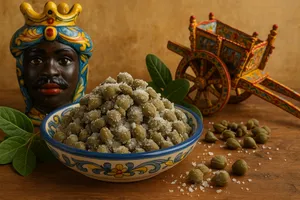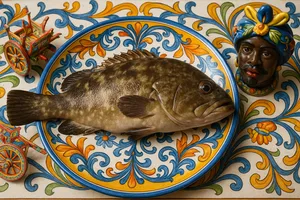Overview
Blackberries, called “rova” in Sicilian, are the fruits of the bramble (Rubus ulmifolius and other species), a spontaneous plant that grows abundantly in the countryside, at the edges of woods, along roads and in fallow land throughout Sicily. These aggregate fruits, a glossy blackish violet at full ripeness, sweet with a slight acidity, are among the most generous gifts of Sicilian nature, freely available to anyone willing to gather them with a little patience and due attention to the sharp thorns that guard the bushes.
In Sicilian tradition, blackberry picking was a summer activity mostly enjoyed by children and young people, who would return home with buckets full of fruit and hands stained purple. Blackberries were a free and delicious treat, eaten fresh straight from the bush or brought home to make fragrant jams, syrups, granita and sweets. Although wild berries were freely available, they have always held great value in Sicilian home cookery. Today, alongside wild blackberries, thornless cultivated varieties exist, larger and more productive, though many believe that wild berries have a more intense and authentic flavour.
Characteristics
Blackberries appear as aggregate fruits composed of many small drupes clustered together, elongated or oval in shape, measuring 1–3 centimetres depending on species and conditions. They begin green, then turn red, and finally become blackish violet at full ripeness.
The surface is glossy and bright when ripe. The texture is soft and juicy, almost melting in the mouth when perfectly mature. The flavour is sweet-tart, with sweetness prevailing in ripe fruits and tanginess in those not fully ripe. The aroma is delicate, fruity and distinctive.
Quality blackberries are fully black (not red or reddish, signs of immaturity), glossy, firm but not hard, sweet and juicy. They detach easily from the receptacle when ripe. Overripe berries tend to fall apart and ferment quickly.
Wild and cultivated blackberries
Wild bramble blackberries
These grow spontaneously in the Sicilian countryside on very thorny brambles. They are smaller than cultivated varieties but have an intense, sweet-tart, aromatic flavour. Picking them is labour-intensive and “painful” due to the thorns, but the result is worth the effort. They are entirely free and grow wherever conditions are suitable.
Cultivated thornless blackberries
Varieties selected for cultivation, with plants lacking thorns or with greatly reduced spines. The fruits are larger, more elongated, glossy black, sweet and juicy. They are easier to harvest and more productive. Their flavour, although excellent, is generally less intense than that of wild berries.
Mulberries
Although sometimes called “blackberries” in some areas, they are actually mulberries, the fruit of a completely different tree. They have a cylindrical, non-aggregate form and a different flavour. They should not be confused with true bramble blackberries.
Habitat and foraging
In Sicily, brambles grow spontaneously practically everywhere: at the edges of fields, along roads and paths, in fallow land, at the edges of woods, along watercourses. They prefer sunny or semi-shaded spots and even poor soils, and act as pioneers quickly colonising abandoned land.
Bramble bushes form impenetrable tangles of thorny branches that can extend for metres. Flowering occurs in spring (April–May) with white or pinkish blossoms much visited by bees. The fruits ripen from June to August, peaking in July, in a staggered manner: on the same bush one may find ripe berries, unripe berries and flowers.
Picking requires care and appropriate clothing to protect from thorns: long sleeves, trousers and sometimes gloves (although picking with gloves is less practical). Ripe berries detach easily with a light touch. It is best to forage in the cool hours of the morning when the fruits are more turgid.
Only fully black, ripe berries should be gathered. Red or reddish ones are unripe and acidic. Care must be taken not to crush the berries, which are extremely delicate. Shallow containers are used to avoid squashing those at the bottom.
Culinary uses
Blackberries have numerous uses in Sicilian cookery.
Fresh consumption
The simplest and most appreciated use. Fresh blackberries, just picked or well chilled, make a delicious and refreshing snack. They may be eaten plain or with a sprinkle of sugar and a few drops of lemon.
Blackberry jam
Blackberry jam has an intense dark-purple colour and a distinctive sweet-tart flavour. It is excellent spread on bread or used to fill tarts and biscuits. The seeds remain in the jam, giving a slight crunch. Those who prefer a seedless jam may sieve it after cooking.
Blackberry syrup
Cooking blackberry juice with sugar yields a syrup with an intense red-purple colour and concentrated flavour. It is used to prepare granita, refreshing drinks, or to garnish ice creams and desserts. Blackberry granita is a refreshing summer speciality.
Sweets and cakes
Fresh blackberries decorate and enrich cakes, tarts, cheesecakes and pavlovas. They may also be used in batters for muffins, loaf cakes or crumbles. Their vivid colour creates striking visual contrasts.
Ice cream and sorbet
Blackberry ice cream has an intense purple colour and distinctive flavour. The sorbet is particularly refreshing and intensely flavoured. Both are prized artisanal specialities.
Sauces for meats
A less common but interesting preparation: sweet-and-sour sauces made from blackberries to accompany game or duck. The sweet-tart profile of the berries balances the savouriness of the meat.
Blackberry vinegar
Blackberries macerated in wine vinegar with sugar produce a sophisticated sweet-sour condiment for salads, cheeses and meats.
Blackberry liqueur
Blackberries macerated in alcohol with sugar yield a liqueur with an intense colour and distinctive flavour. It is a traditional homemade digestif in some rural Sicilian areas.
Preparation
Blackberries must be handled gently as they are extremely delicate. They should be washed briefly and carefully just before use, by immersing them in cold water and draining immediately, or by rinsing them lightly under a gentle stream. They should not be washed under a strong jet as they tend to disintegrate.
They are dried by patting very gently with kitchen paper. Any remaining stems or small leaves are removed. Blackberries are used whole or, for some preparations, crushed to extract their juice.
For jams and syrups, the berries are cooked with sugar and lemon. Cooking should not be overly prolonged to preserve colour and aroma. The seeds remain in the preparation, giving texture, or can be removed by sieving or passing through a food mill.
Storage
Blackberries are among the most perishable fruits. They keep in the refrigerator for only 1–2 days, arranged gently in a single layer on a plate lined with absorbent paper. They should not be washed before storage as moisture accelerates deterioration.
They must not be heaped together as they crush easily and release their juice. They should be consumed as soon as possible, ideally on the day of picking, when they are at their peak of freshness and flavour.
Blackberries freeze very well: arranged on trays and frozen quickly, then transferred to airtight containers. They keep for 8–12 months and are excellent for desserts, jams and smoothies. They can also be frozen as purée or with sugar. Once thawed, they lose their firmness but retain flavour and colour.
Foraging tips
Blackberries are rarely available at markets due to their extreme perishability and because commercial harvesting is not economically viable given the abundance of free wild berries. If found, select fruits that are fully black, glossy, firm but not hard, with no mould or signs of fermentation.
The best way to have fresh blackberries is to pick them yourself. Foraging tips:
- Dress appropriately: long sleeves, sturdy trousers, closed shoes.
- Bring shallow containers to avoid crushing the berries.
- Pick only fully black berries, leaving red or reddish ones.
- Avoid berries near busy roads (pollution) or fields treated with pesticides.
- Forage respectfully, always leaving fruit for wildlife and for the plants’ reproduction.
- Beware of wasps and other insects attracted to ripe berries.
- During hot hours, berries may harbour small insects: morning foraging is preferable.
Nutritional properties
Blackberries are relatively low in calories: 100 grams provide around 40–45 calories. They are about 85% water and contain roughly 10 grams of carbohydrates per 100 grams, mainly simple sugars. They contain about 1.5 grams of protein; fats are minimal.
They are rich in vitamin C (around 20–25 mg per 100 grams), important for the immune system. They contain vitamin K, vitamin E, folate and B vitamins. They are a good source of potassium, magnesium, calcium and manganese.
They are particularly rich in antioxidants, especially anthocyanins (responsible for the purple-black colour) with strong protective properties, as well as other polyphenols. They have anti-inflammatory and protective effects studied by scientific research. They also contain fibre, which supports regular digestion.
In Sicilian folk medicine, blackberries were considered beneficial, purifying and refreshing. They were given to children and convalescents as a natural tonic. Bramble leaves were used to prepare infusions considered astringent, useful in cases of diarrhoea.
The bramble in Sicilian culture
The bramble has always had an ambivalent relationship with Sicilian farmers. On the one hand, it was seen as a weed invading cultivated and abandoned land, extremely difficult to eradicate due to its deep roots and vigorous growth. On the other, it provided free blackberries, hosted bird nests, and its thorny bushes were used as natural barriers to mark boundaries or protect vegetable gardens.
Bramble branches were gathered after pruning and used as firewood in wood-fired ovens, burning quickly with a lively flame, ideal for lighting fires. In some areas, young spring shoots of the bramble were harvested and eaten cooked as a vegetable, once the thorns were removed.
Curiosities
In Sicilian popular tradition, it was believed that eating blackberries after Saint Michael’s Day (29 September) brought bad luck, as it was said the devil had spat on them. In reality, after September the remaining berries are often dry, wormy or fermented, so this belief had a practical basis: avoiding fruit that was no longer good.
An old Sicilian saying goes: “Cu’ voli i rova, s’havi a punciri” (Whoever wants blackberries must prick themselves), a metaphor meaning that to obtain something good one often has to face discomfort or difficulty. The bramble’s thorns represented the “effort” required for the reward of the sweet berries.
Sicilian children invented games and challenges during blackberry picking: who could gather the most berries, who could find the largest one, who could manage without being pricked. Purple-stained mouths and hands were a badge of honour showing they had been “hunting blackberries”.
In some rural Sicilian areas, a tradition known as “passata di more” existed: similar to tomato passata, blackberries were sieved to remove the seeds, producing a thick purée that was then cooked with sugar or stored for winter. It was a way of using abundant harvests of wild berries.
The bramble’s thorns, although a nuisance during picking, had a traditional use: old farmers used them as natural pins to fasten silkworm cocoons or for small emergency repairs, thanks to their sturdiness and hooked shape.
Blackberries featured in an old Sicilian folk remedy for sore throats: a thick syrup made with blackberry juice and honey, taken by the spoonful. The astringent properties of the berries and the soothing qualities of honey provided relief. It was one of the home remedies passed down from grandmothers.
Today, with the abandonment of farmland and the spread of brambles over fallow land, wild blackberries are more abundant than ever in Sicily. Paradoxically, however, they are gathered far less than in the past: younger generations often no longer practise this traditional activity, and kilos of berries ripen and fall unpicked, whereas once every berry was precious to rural families.

